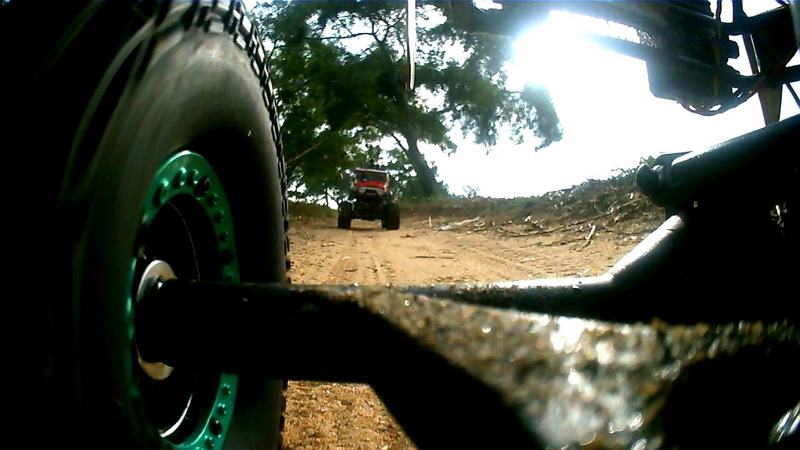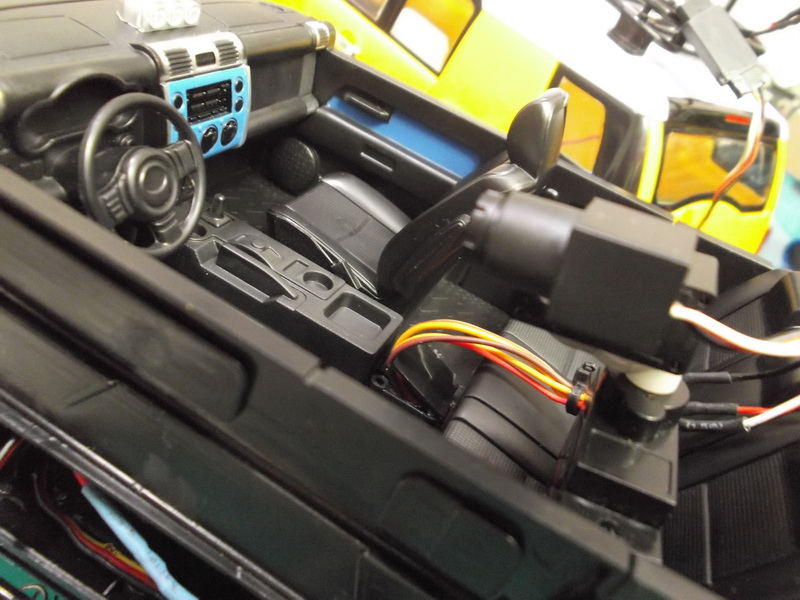
About
Ah! the we're coming to the end of 2018 ready to greet the year 2019 its been almost a decades flying both in FPV or UAV models, it allows me to discover new world and cool places from above. Before we're jumping into year 2019 its about time for me to write an interesting documentation which i forgot to elaborate about my side hobby which i've been enjoy for years but keep low profile for a while; FPV off-roading or FPV 4x4'ing. Its always been my childhood dream to sit inside the cockpit of the most famous warbirds and surf above the majestic clouds of the blue horizon. You've seen them in my Youtube video channel with FPV/drones flight spanned over many years worth of thrilling adventures so i guess you knew the feeling being in it. But let's not forget that even our own backyard at ground zero also can be a source of fun and excitement using the same technology without cling too much around the puffy clouds. In this article i'm going to talk about ground drone but more specific to off-road FPV driving inside the cockpit of ground base R/C models such as buggies and trucks. Similarly like driving simulator in PC or console game but we're driving for real in miniature size backyard or around the park with range limited by our FPV setup.
worth of thrilling adventures so i guess you knew the feeling being in it. But let's not forget that even our own backyard at ground zero also can be a source of fun and excitement using the same technology without cling too much around the puffy clouds. In this article i'm going to talk about ground drone but more specific to off-road FPV driving inside the cockpit of ground base R/C models such as buggies and trucks. Similarly like driving simulator in PC or console game but we're driving for real in miniature size backyard or around the park with range limited by our FPV setup.
Let's not forget the fact that the first 'civilian' DIY drones published in the media (television) was actually a home build made out of R/C car with CCTV camera sticking on top of the hood back in the 80's or 90's featured in the movie.....i forgot the title of the movie. Almost 30 years later we're doing the same thing with more improve technology cramming into sleek looking R/C models which we could proudly called ground FPV drone. My passion for FPV driving rooted back when i was young age in the 1980's was all about imagining how cool it would be if i could drive an R/C buggy (TAMIYA) or truck from cockpit view via wireless video technology and travel to many places while sitting at home indulge the sense of 80's Camel Trophy 4x4 adventures into the forest, plowing through muds and woodlands since my grandparent lives in rural villages which is why i fond of off-road buggies and trucks....unfortunately we don't have such technology yet and FPV was unheard of. Back to present day in the era of year 2000 now as an adult i splurge all my budget to full fill my long lost childhood ambition and started to build my dream FPV models. I can't recall how many FPV trucks, buggy or car have been made since 2012 but all i knew it was build parallel to the development of my FPV and UAV aircraft but i didn't put much spotlight in the news or social media because wheeled FPV wasn't much trendy thing until it went full blast by late year 2016. My first awesome cockpit FPV driving was build on cheap china made toys replica of TOYOTA FJ truck...bet you saw in on my old videos collection....then i was hooked!
Why scale cockpit driving?
So what so cool about FPV off-roading inside the cockpit of an off-roader and what thrills or expectation do we get by crawling on the ground? Based on my experience and also being with other people with the same passion its all about 'self adventure' and technically challenging yourself overcome 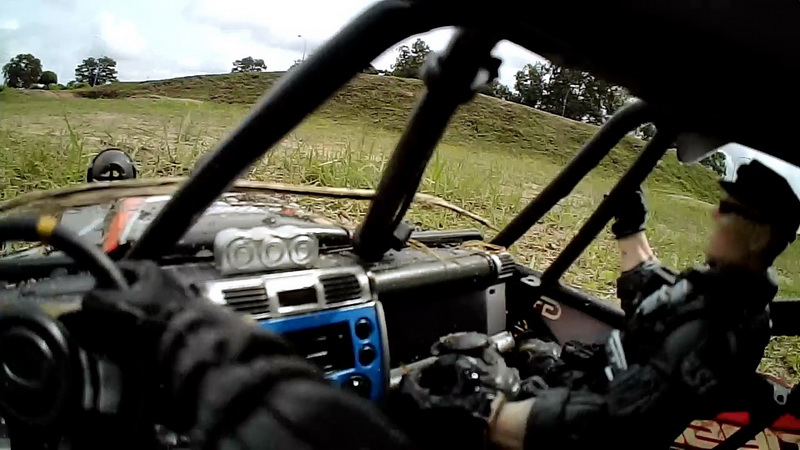 every obstacles coming right at you ....pretty much same can be said when flying FPV racing quadcopter through hoops and trees but FPV off-roading buggy and trucks comes with style!
every obstacles coming right at you ....pretty much same can be said when flying FPV racing quadcopter through hoops and trees but FPV off-roading buggy and trucks comes with style!
My first wheeled FPV build wasn't interesting one but as i get further with gradual improvement it has gotten improve and immersive until it get far addicted then being on FPV planes or even FPV multirotor...it seems that FPV off-roading have it own quirky world to enjoy..even a small room full of garbage or around my office it can be a fun place to drive around (my FPV Basher Rockta). Unlike FPV planes where you can relax float around and enjoy new found world or surf around the clouds under its wing the FPV off-roading give another new sense of adventure and challenges to keeps your adrenaline pumping for hours; these are like speeding down the trails/roads, feeling extreme G-force at cornering, few milliseconds of close calls or missed with obstacles, power drift around corners, throttle frenzy feeling hearing the engine screaming and turbo boosting (if you have engine sound hardware installed), slalom around obstacles like you'd usually do like race quadcopters, rock crawling, plow through dirt/muds, enjoy watching those mechanical movement of front suspension and wheels in action, tandem driving or racing with buddy as if you're doing Dakar Rally and most importantly being so cool sitting inside your scaled looking Jeep, Toyota Land Cruiser or maybe driving in your scaled Lancia Stratos car complete view of realistic functional steering wheel and dashboards....just like you would experience in game racing simulator.
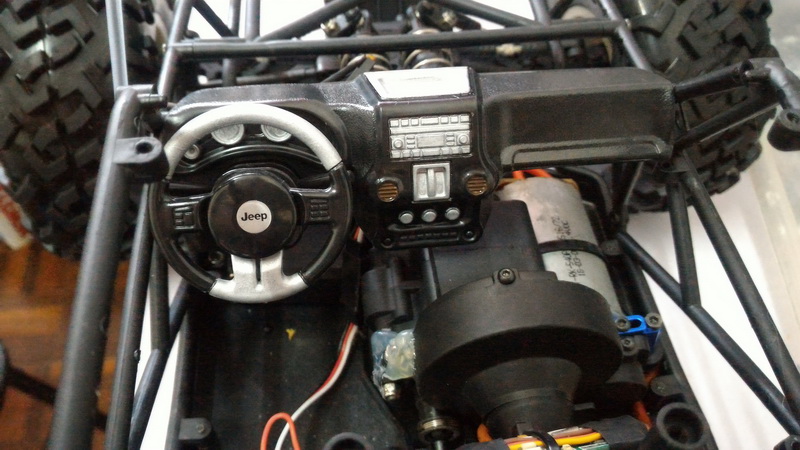
My generic off-road model specification on 1:10 and 1:12 scale
*Note: Because i have lot of FPV off-roader build on different platform/types/brands i only listed parts that are commonly used on my wheeled models.
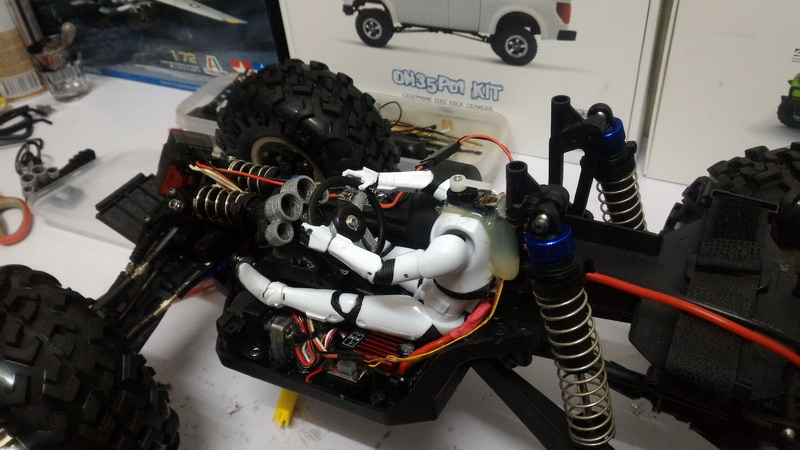 Platform: Scale trophy truck/rock racer/rock crawler
Platform: Scale trophy truck/rock racer/rock crawler
Drivetrain type: 4WD/AWD/2WD
ESC: HOBBY WING 1060A 60A Brushed ESC with internal 5V/2A BEC
External BEC: 5V/3A
Steering servo: High torque metal gear servo
Cockpit panel's 'aesthetic' driver's steering servo: 9g mini metal gear servo
Radio receiver: RadioLink R4EH-G and R4EH-H
Radio receiver antenna: Stock di-pole
Battery: 2s 2200mah~5200mah (7.4v) li-po pack
My common FPV hardware specification
Camera HD (main/recordable): RUNCAM HD 1080p F2.8 or 808 #16 HD 720P (with live video output)
Pan camera: 9g mini servo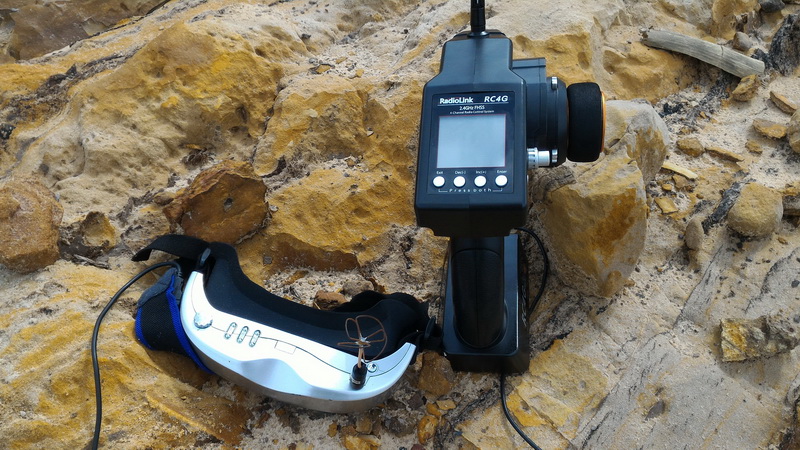
OSD: Simple OSD
Video transmitter: EACHINE/SKYZONE/TAROT 5.8ghz 200mw~1000mw
Video antenna: DIY tuned Clover Leaf
Battery: Shared with main.
My FPV driver hardware specification
Radio controller/transmitter: RadioLink RC4G (4 channel)
FPV video goggle: BOSCAM GS-920 8CH with build in 2.4Ghz/5.8Ghz receiver + DIY tuned SPW antenna.
FPV video DVR unit: EACHINE Pro DVR Mini
The build and tips
I don't want to elaborate further about how individual components of FPV hardware are connected to each other but you can refer from the schematics above (top image) for direct reference which sums up everything. FPV equipment used on my ground models is cheaper, easy to implement and less risky to technical failure than aircraft models such as planes and multirotor/quads because it doesn't need to use flight controller or any autopilot system with GPS. The most important to note about when implementing FPV on any R/C on-road or off-roader is it must have reliable and steady 5V current supply from BEC and highly recommended to have external 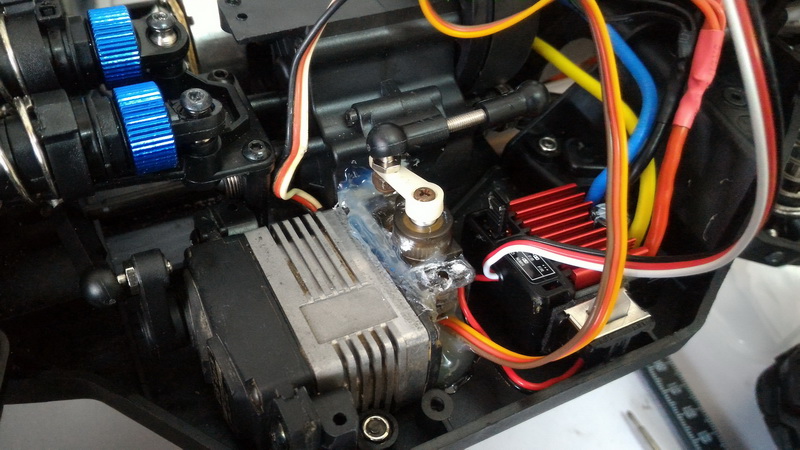 BEC/UBEC that supplies at minimum 3A current to overall electronics onboard the model which enough to power 2x mini servo, 1x receiver, 1x FPV HD recordable camera and optional hardware such as the sound unit. The other remaining BEC which come from ESC internal unit (default 5V/1A) can be used to power 1x large 1:10 size high torque servo and extra auxiliary 5V hardware consume at 500mA each. So that means you should have total of 2x BEC sources ready available on your full laden FPV off-roader model as indicated by my FPV electronic schematics photo shown above. Based on my experience if you solely depends on single ESC's internal BEC to power the FPV equipment a 5V/2A BEC from HOBBY WING 1060A brushed ESC is enough to power 1x 1:10 scale stock analogue servo, 1x mini 9g servo, 1x radio receiver and 1x FPV HD camera only.....however at full throttle where power is much demanding by the motor the current may surge to lower level plus influence by heat may cause the ESC to shutdown (thermal protection) due to heat generated by BEC's FET chipset and BEC causing your models to "brownout" (lack of current) or stall...this happened a lot on my early build 1:12 Feiyue FPV off-roader..but now it have dual source of BEC supply. Cheap 'stock' ESC that comes with most RTR unit such as for example TAMIYA TBLE-02S unit have only 5V/1A rated internal BEC than only can support basic amount of R/C hardware lugged where it can only have 1x standard size 1:10 scale FUTABA S1001 type servo and radio receiver unit...adding another mini size 9g servo highly likely to burn the internal BEC which happens a lot to me. Since you all know i owned lots of TAMIYA R/C models (re-released models) you might expected i've burned lots of ESC along my trial build....aahh! the pain in my pocket! So if you planned to get a new ESC regardless either brushed or brushless type don't cut corner on the cost, get quality ones. But if you confused with too many option available in the market then put 'HOBBYWING' brand into your list because they are reliable for years and i've been using their products for decades now...used to be fans of CASTLE CREATION ESC..not anymore.
BEC/UBEC that supplies at minimum 3A current to overall electronics onboard the model which enough to power 2x mini servo, 1x receiver, 1x FPV HD recordable camera and optional hardware such as the sound unit. The other remaining BEC which come from ESC internal unit (default 5V/1A) can be used to power 1x large 1:10 size high torque servo and extra auxiliary 5V hardware consume at 500mA each. So that means you should have total of 2x BEC sources ready available on your full laden FPV off-roader model as indicated by my FPV electronic schematics photo shown above. Based on my experience if you solely depends on single ESC's internal BEC to power the FPV equipment a 5V/2A BEC from HOBBY WING 1060A brushed ESC is enough to power 1x 1:10 scale stock analogue servo, 1x mini 9g servo, 1x radio receiver and 1x FPV HD camera only.....however at full throttle where power is much demanding by the motor the current may surge to lower level plus influence by heat may cause the ESC to shutdown (thermal protection) due to heat generated by BEC's FET chipset and BEC causing your models to "brownout" (lack of current) or stall...this happened a lot on my early build 1:12 Feiyue FPV off-roader..but now it have dual source of BEC supply. Cheap 'stock' ESC that comes with most RTR unit such as for example TAMIYA TBLE-02S unit have only 5V/1A rated internal BEC than only can support basic amount of R/C hardware lugged where it can only have 1x standard size 1:10 scale FUTABA S1001 type servo and radio receiver unit...adding another mini size 9g servo highly likely to burn the internal BEC which happens a lot to me. Since you all know i owned lots of TAMIYA R/C models (re-released models) you might expected i've burned lots of ESC along my trial build....aahh! the pain in my pocket! So if you planned to get a new ESC regardless either brushed or brushless type don't cut corner on the cost, get quality ones. But if you confused with too many option available in the market then put 'HOBBYWING' brand into your list because they are reliable for years and i've been using their products for decades now...used to be fans of CASTLE CREATION ESC..not anymore.

The second important issues is the radio's receiver Fail Safe feature. Your radio unit on both control transmitter and receiver unit must able to support FAIL SAFE if the radio model losses radio signal in certain range and distance, ensure that any radio channel especially throttle channel (CH2) are force to stop/brake when the model losses its radio connection thus avoid the model from 'runaway' consequently hitting or injured living thing or property around its surroundings. If setting up a fail safe on radio receiver is not possible some ESC unit that control the motor have Fail Safe build-in to protect the models from throttling when radio signal is not present/absent. The third vital tips is about radio frequency separation onboard the FPV models between the radio receiver unit and video transmitter unit. Regardless of big frequency gap between 2.4ghz radio receiver for controlling models and all popular 5.8ghz for FPV video transmission both unit must be located as far away as possible between each other on the platform and this can be critical of your models if below 1:12 scale. If you look around all my FPV off-road setup my radio receive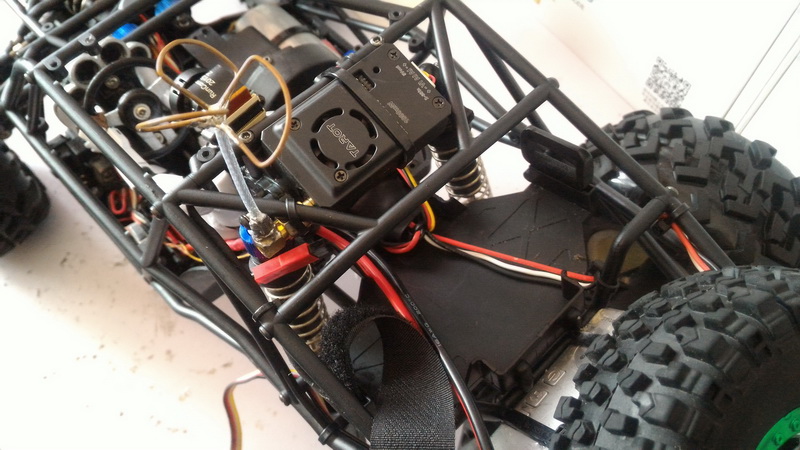 r always located at far front end of the chassis while the video transmitter is located far rear end of the chassis to avoid interference in both RF and electromagnetic issues. The radio receiver onboard always get hit the hardest when in comes to RF interference so its best to keep distance away from servos, cameras, ESC, sound system unit and BEC module which is why the front chassis is always the best and void of all R/C electronics placement. The height of both radio antenna also play a crucial role for efficient range and coverage, the height antenna are given priority to 5.8Ghz video antenna with its main antenna trunk being the tallest because it has low radio penetration factor behind obstacles and need much ground clearance to avoid RF bounce off the ground. 2.4Ghz radio receiver for controller comes in second because it penetrate better than its 5.8ghz counter part however both antenna should always be positioned upright parallel to the driver's transmitting and receiving antenna at home base. Some FPV builder may opt for other frequency such as 433/72/42/35mhz for radio and 2.4ghz/1.2ghz/1.3ghz/900mhz for video but the implementation remain the same and caution that extra RF filtering parts/accessories required for specific video transmitter (eg: 1.2ghz/1.3ghz/900mhz). So those are the important key point of setting FPV equipment on ground R/C models while the rest are pretty much basic FPV setup which you can refer from any FPV community online. When talking about radio and video range the efficiency is just 1/3 of what can be achieved on FPV fixed wings or multirotor up in the airt/sky because crawling on the ground the radio frequency both radio controller and video subject to interference and ground reflection noise. With 5.8Ghz 600mw video transmitter on plane i can easily get clean range of 13~16KM with clover leaf antenna on transmitter and helical antenna on receiver. However for ground FPV use like on my truck realistically you can only get around 600m~1200m either average or random efficiency depending the obstacles encounter by straight line radio transmission with the same 5.8Ghz 600mw hardware used as mentioned before.
r always located at far front end of the chassis while the video transmitter is located far rear end of the chassis to avoid interference in both RF and electromagnetic issues. The radio receiver onboard always get hit the hardest when in comes to RF interference so its best to keep distance away from servos, cameras, ESC, sound system unit and BEC module which is why the front chassis is always the best and void of all R/C electronics placement. The height of both radio antenna also play a crucial role for efficient range and coverage, the height antenna are given priority to 5.8Ghz video antenna with its main antenna trunk being the tallest because it has low radio penetration factor behind obstacles and need much ground clearance to avoid RF bounce off the ground. 2.4Ghz radio receiver for controller comes in second because it penetrate better than its 5.8ghz counter part however both antenna should always be positioned upright parallel to the driver's transmitting and receiving antenna at home base. Some FPV builder may opt for other frequency such as 433/72/42/35mhz for radio and 2.4ghz/1.2ghz/1.3ghz/900mhz for video but the implementation remain the same and caution that extra RF filtering parts/accessories required for specific video transmitter (eg: 1.2ghz/1.3ghz/900mhz). So those are the important key point of setting FPV equipment on ground R/C models while the rest are pretty much basic FPV setup which you can refer from any FPV community online. When talking about radio and video range the efficiency is just 1/3 of what can be achieved on FPV fixed wings or multirotor up in the airt/sky because crawling on the ground the radio frequency both radio controller and video subject to interference and ground reflection noise. With 5.8Ghz 600mw video transmitter on plane i can easily get clean range of 13~16KM with clover leaf antenna on transmitter and helical antenna on receiver. However for ground FPV use like on my truck realistically you can only get around 600m~1200m either average or random efficiency depending the obstacles encounter by straight line radio transmission with the same 5.8Ghz 600mw hardware used as mentioned before.
So to re-cap most important issue that i've mention before below are vital points for setting up an FPV truck...
- External BEC - Must have reliable standalone BEC module at least 5V/3A rating to support multiple FPV hardware that feed on 5V..which leaves stock ESC's internal BEC is good enough just to power main steering servo and additional mini 9g servo.
- Radio Fail Safe - Always make sure your radio receiver have FAIL SAFE support on all channel or at least on throttle channel to avoid model uncontrolled/lose control 'runaway'.
- Radio separation - Both radio receiver (controller) and FPV video transmitter must be separate as far away as possible on platform, antenna always at higher position and upright. Keep the radio receiver away from other electronics devices onboard.
FPV radio and video range coverage
Here are summary of estimated FPV range that i've obtained by running several type of FPV video transmitter on various off-road models i owned with given condition and parameters as shown below. Do take note that different hardware, setup and other environment factor may show different result on different user:
----------------------------------------------------------------------------------------------------------------------------------
+ Area condition: Normal park size with trees, man made solid object such as statue, small walls, hut and lamp post.
+ Terrains: Almost flat with 2 meters elevation.
+ Radio interference: Tele communication tower within 100m range, CCTV and WIFI.
So the video distance/range acquired running on 5.8Ghz video transmitter unit :
-
EACHINE F-14 RatingKing's buggy stock 5.8Ghz 25mw module (build-in OSD) + long monopole antenna = 189~200 meter (Approximate value).
-
EACHINE standalone 5.8Ghz 200mw module + DIY tuned cloverleaf antenna = 300~500 meter (Approximate value).
-
SKYZONE standalone 5.8Ghz 600mw module + DIY tuned cloverleaf antenna = 600~800 meter (Approximate value).
-
SKYZONE standalone 5.8Ghz 600mw module + DIY tuned cloverleaf antenna + Directional Helical antenna on receiver side = 600~1200 meter (Approximate value).
-
TAROT standalone 5.8Ghz 1000mw module + DIY tuned cloverleaf antenna = 800~1200 meter (Approximate value).
* Radio controller and receiver unit is using RADIO LINK RC4G (early production) which provide average max 1200m of radio range/distance.
* FPV goggle used is the classic BOSCAM GS920 (8CH 2.4Ghz/5.8Ghz) with DIY SPW antenna.
* Distance is measured using Google Map via visual landmark marking.
----------------------------------------------------------------------------------------------------------------------------------
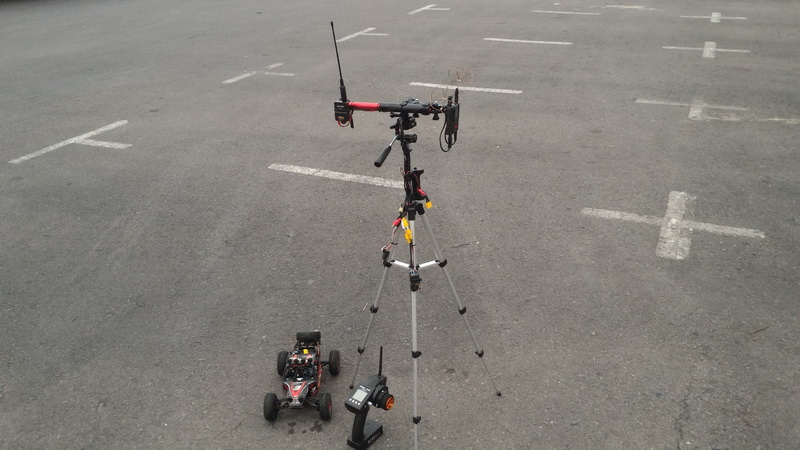
Your first FPV setup can get away with cheap and simple build as long the above points are taken seriously into your FPV models. When talk about costing however the wheeled platform like R/C car, trucks or buggies are far more expensive for one time purchase than foamy R/C plane because it has more rigid parts, moving gears, suspension, heavy duty wheels and etc especially when you're using models scale above 1:10 to 1:5 size. However thebasic FPV hardware required for the setup is cheaper and simplified than flight models due to absent use of GPS and flight controller which required on planes and multirotor/quads. For some ground FPV models an OSD can be an optional too just to save up the cost. Due to wheeled platform have more moving parts the maintenance also can higher due to wear and tear like worn out tyres, spur gear, pinion gear, leaky suspension or maybe broken suspension wishbone upon side impact if not carefully driven, fortunately for me i haven't worn-out any parts on any of my scale FPV off-roader even running for 5 years average yet because when you drive inside FPV cockpit even seen fast from FPV point of view inside the cockpit actually the models run at moderate speed not enough to cause any parts to wear out so that mean you don't need to go brushless for extra speed. Below are few pointer how to be on the right track choosing your ideal platform:
- Choosing the right platform
When planning to buy your first FPV model for off-roading its highly recommended to choose minimum AWD/4WD 1:10 scale size with high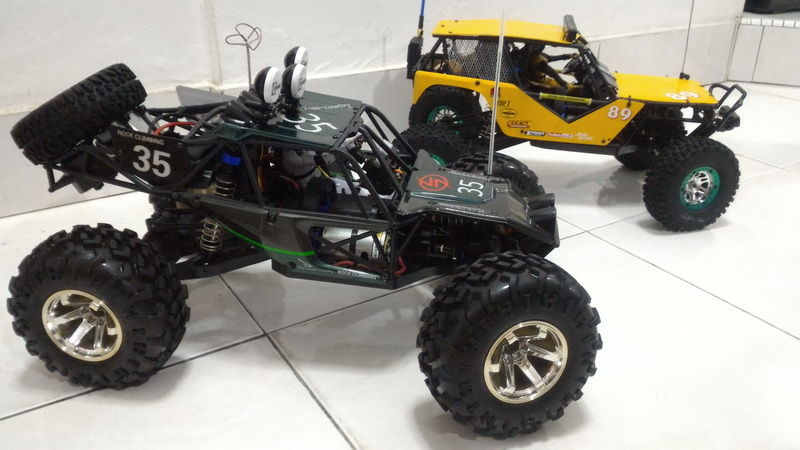 ground clearance between the ground and the bottom chassis high enough not to get stuck on its belly when lunge over some roots, rocks or any obstacles. Quick way to know which off-road models could fare well for serious all terrain FPV is by sliding your grasp hand fist under carriage of the model and see if it can fit nicely under it without struggle. Trophy truck, rock crawler/rock racer, Truggy and Monster Truck usually have ample clearance than any models in the market which is why they are popularly seen on Youtube video eg: a TRAXXAS SUMMIT. A baja style sand buggy could be a good candidate unless if you could find a 4WD. Plus having minimal 1:10 scale spare parts are easy to find both online and locally especially when looking for alterative wheels or tire size to counter various terrains, replacing worn out spur or pinion gear, motors, servo and etc. Also 1:10 scale is the ideal minimum size to mount FPV camera, cam pan servo, steering, seat, dash panel and driver figurine inside the model cockpit cavity. 1:10 scale chassis also has more room to place your FPV equipment and tidy up those wiring.
ground clearance between the ground and the bottom chassis high enough not to get stuck on its belly when lunge over some roots, rocks or any obstacles. Quick way to know which off-road models could fare well for serious all terrain FPV is by sliding your grasp hand fist under carriage of the model and see if it can fit nicely under it without struggle. Trophy truck, rock crawler/rock racer, Truggy and Monster Truck usually have ample clearance than any models in the market which is why they are popularly seen on Youtube video eg: a TRAXXAS SUMMIT. A baja style sand buggy could be a good candidate unless if you could find a 4WD. Plus having minimal 1:10 scale spare parts are easy to find both online and locally especially when looking for alterative wheels or tire size to counter various terrains, replacing worn out spur or pinion gear, motors, servo and etc. Also 1:10 scale is the ideal minimum size to mount FPV camera, cam pan servo, steering, seat, dash panel and driver figurine inside the model cockpit cavity. 1:10 scale chassis also has more room to place your FPV equipment and tidy up those wiring. - 4WD, AWD or 2WD transmission
Its best to avoid 2WD if you're seriously into off-roading..i do have 2WD FPV buggy (HuanQi 739 or aka TEAM-C TC02) they are fast and fun because of rear torque and power slide action which is best for flat trails, tarmac or on-road use plus low maintenance. The drawbacks is they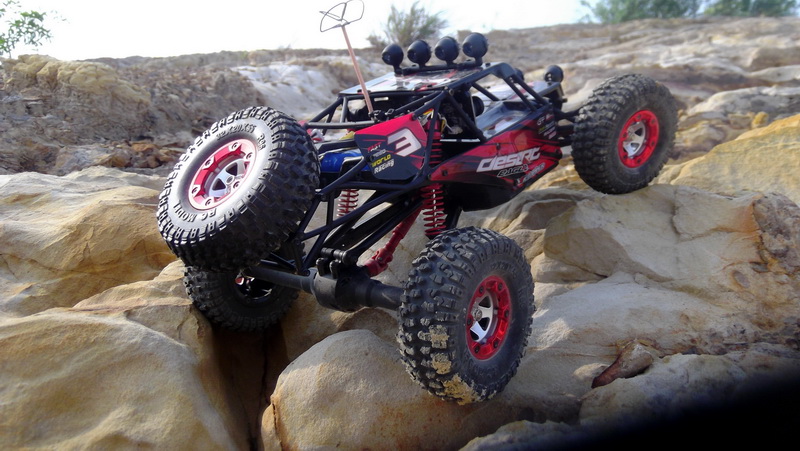 always get stuck easily on grass, tree roots and small ditches which prompt me to walk half kilometers to recover it. If you don't want to get stuck during off-roading a high viscosity differential gear oil/grease should be added inside the differential planetary gear to make sure both wheels could pull you out from sticky situation but at the expense of reduce performance during sharp cornering.
always get stuck easily on grass, tree roots and small ditches which prompt me to walk half kilometers to recover it. If you don't want to get stuck during off-roading a high viscosity differential gear oil/grease should be added inside the differential planetary gear to make sure both wheels could pull you out from sticky situation but at the expense of reduce performance during sharp cornering.
AWD is great for overall driving, AWD (All Wheel Drive) defined when both drive differential (unlocked) spins freely on 4 wheels which allow better controls during slippery cornering, equal traction during high speed off-roading or rough bashing in all terrains. 4 wheels naturally adjust its own pace to cope with different terrains. In short words; AWD is good for off-road racer, cornering and speed without slipping too much such as oversteer and understeer.....its like having nice ABS system on 4x wheels.
4WD are more likely a rock crawler drivetrain configuration where both differential are locked and all 4 wheels are turning equally and sync with each other which ideal for slow or moderate speed driving on all terrains, slippery soil, serious rock or slippery hill climbing and most importantly will get you out from sticky situation like getting out from deep potholes, drains and places where there are high risk of getting stuck 100%. The drawback are its not recommended to drive on pavement or on solid tarmac especially cornering at high speed because of locked differential may strain the drive shaft on each side of the wheel, slower than AWD due to all 4 wheel drive synchronously. 4WD are more commonly adopted standard by any FPV off-roading enthusiast around the globe where their differential gear are fully locked or something semi locked by the use of heavy differential oil/grease where driving emphasize at moderate or slow pace. - Camera angle
This is the most important and considered the most paramount factor that justify how much FPV experience we could get from FPV driving. If you get the camera angle wrong your FPV experience on wheel will be busted, almost 70% newbies got it wrong and never to return to their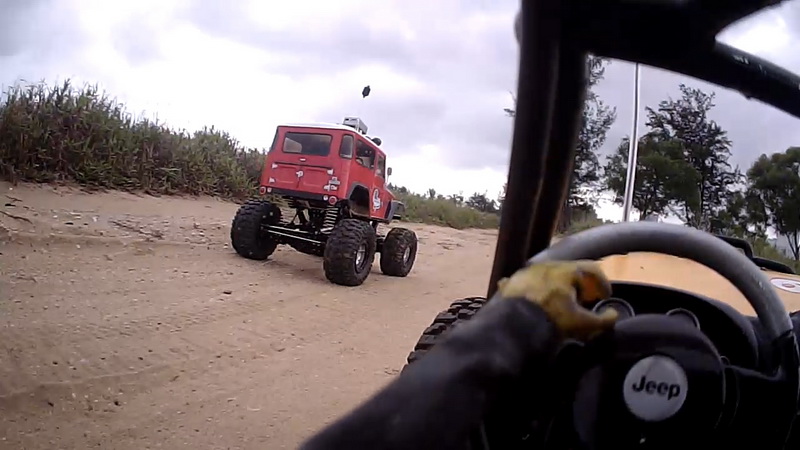 FPV driving ambition because they felt FPV driving sucks due to struggling to see onboard their FPV model. The same true if you setup your camera at wrong angle on planes or multirotor; too high you won't able the ground for landmarks and landing, too low you can't see the skies to enjoy the view and horizon. Camera FOV (Field Of View) degree/angle play the key role; too wide you'll get fish lens effect, you'll get disorientated like looking through fish bowl. Too narrow, you can't anticipate what's coming around the corner. These crucial factor what makes FPV experience a success...in all my FPV videos you will notice i have full view of where i wanted to go and see what i wanted to see from cockpit perspective view without having to pan my camera around on servo panning because it has the correct camera angle where i wanted. As in camera setup in my the cockpit i had a full view of the steering wheels, dashboards, front hood for orientation, front wheels, the incoming ground/terrains, the horizon and full side view via camera servo panning for extra extended left and right view so i know what's coming around the corner. Most popular FOV (Field Of View) lens degree used on FPV is between 120 degree up to 130 degree FOV lens angle on CCD and CMOS camera based camera...majority of my FPV off-roader
FPV driving ambition because they felt FPV driving sucks due to struggling to see onboard their FPV model. The same true if you setup your camera at wrong angle on planes or multirotor; too high you won't able the ground for landmarks and landing, too low you can't see the skies to enjoy the view and horizon. Camera FOV (Field Of View) degree/angle play the key role; too wide you'll get fish lens effect, you'll get disorientated like looking through fish bowl. Too narrow, you can't anticipate what's coming around the corner. These crucial factor what makes FPV experience a success...in all my FPV videos you will notice i have full view of where i wanted to go and see what i wanted to see from cockpit perspective view without having to pan my camera around on servo panning because it has the correct camera angle where i wanted. As in camera setup in my the cockpit i had a full view of the steering wheels, dashboards, front hood for orientation, front wheels, the incoming ground/terrains, the horizon and full side view via camera servo panning for extra extended left and right view so i know what's coming around the corner. Most popular FOV (Field Of View) lens degree used on FPV is between 120 degree up to 130 degree FOV lens angle on CCD and CMOS camera based camera...majority of my FPV off-roader uses this range of lens FOV which give balance for viewable on all corner of the cockpit. I've also added pan servo to extend my view horizontally.
uses this range of lens FOV which give balance for viewable on all corner of the cockpit. I've also added pan servo to extend my view horizontally. - Brushed or Brushless motor?
You don't need to upgrade your stock off-road model to brushless ESC + Motor to get extra speed because speed will depreciate the experience of driving in FPV point of view. If you did you are more likely be experience a bit like 'light speed' on Millennium Falcon as seen on STAR WARS movie..too fast to see or catch up!..because everything around you visually warped like going into hyperspace but in standing point of view (third person view) it doesn't look that fast. That's why almost 80% of FPV off-roader still running on brushed motor or crawler motors (stock silver can motor) at speed moderate enough to enjoy real driving and match actual speed ratio to current scale model. Unless if you want to keep battery power efficiency by going brushless then find motor 'KV' rating that match the current brushed motor T 'Turn' value so you can FPV at drivable speed. - Optional - Enhance the scale FPV driving..adding aesthetic appearance
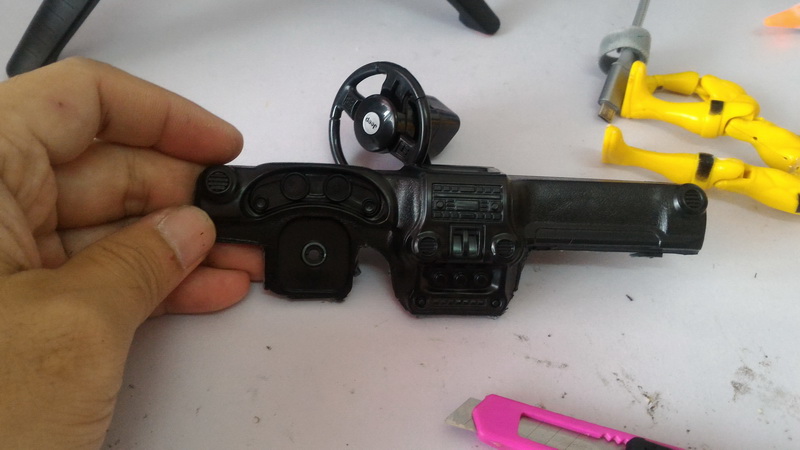 As you all know FPV can be as basic as slapping an FPV camera and video transmitter on the roof to more advance setup that mimic to actual automobile experience with engine sound, moveable dashboard's steering, figurine driver, horns, headlights, gear shift stick, windshield wiper and etc, many PFV'er posted share their videos with their cool mods to make FPV driving as realistic as possible. Its up to individual's creativity to make it works which is why ground FPV creation have no limits to add-on cool scale appearance unlike aircraft models which limited by weight and power onboard. Below are list of my additional 'scale' setup i added to my FPV off-road models to make cockpit driving more realistic:
As you all know FPV can be as basic as slapping an FPV camera and video transmitter on the roof to more advance setup that mimic to actual automobile experience with engine sound, moveable dashboard's steering, figurine driver, horns, headlights, gear shift stick, windshield wiper and etc, many PFV'er posted share their videos with their cool mods to make FPV driving as realistic as possible. Its up to individual's creativity to make it works which is why ground FPV creation have no limits to add-on cool scale appearance unlike aircraft models which limited by weight and power onboard. Below are list of my additional 'scale' setup i added to my FPV off-road models to make cockpit driving more realistic:
- Steering wheel and dashboard:
Dashboards usually i taken from other cheap toy models and added extra 9g size servo to animate the steering wheel movement.
- Figurine/cockpit driver:

Any figurine that fit 1:10 scale will do provided that the arm are not stiff and flexible enough to move along with the steering wheel column. - Engine sound system:
Usually i use SENSE HOBBY ESS-ONE PLUS sound system that could emulate engine sound and have optional horn useful to notify incoming pedestrians or any living thing nearby. Having a horn sound do help to locate the models where about when at lost. - Others aesthetic mods:
Additional figurine for side passenger (on my FY03 model), head/fog lights, gear knob shifter, side mirror and other realistic add-ons to make the models looks more appealing to looks at around the cockpit/cabin.
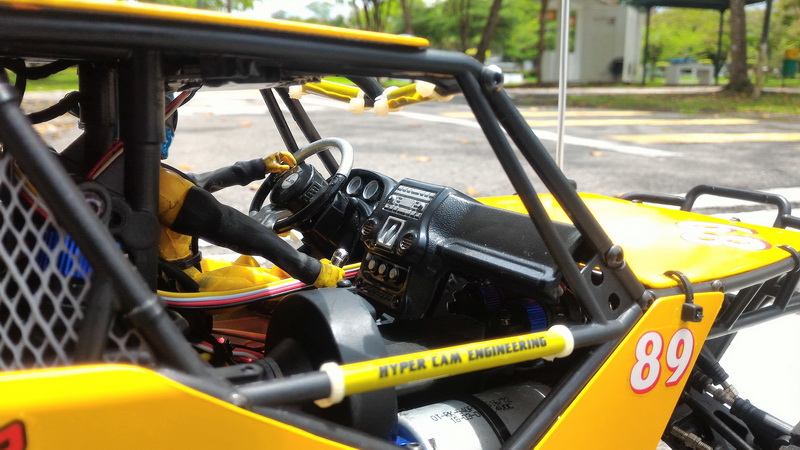
Psychologically if you setup your off-road model close to realism without those FPV hardware bulging out from the body shell, wires nicely hidden, antenna well camouflage, body shell matched to actual replica of existing automobile and chassis size are proportionally to sized with proper wheel base you'll definitely cherished and love your FPV car/trucks due to its scales perfection and from there on continue to support growth their works thus pleasing to general  public when running outdoors...which is true because some owner of these scale creations seems to stay longer and thrive in their FPV driving activity for longer period than 'half baked' FPV off-roader out there among the community. Those people who scaled their models lives to enjoy their pride while those who turned their model unintentionally into Martian rover seems to lasts a few season because they lacked spirit and enthusiasm to move on to improve their models...when they see a junk and doesn't put positive attitude to improve the junk it will be a 'junk'...so some move on flying a multirotor or FPV racing quad. Unfortunately an FPV multirotor doesn't resemble anything of a real life scaled flying aircraft either...not a scaler indeed.
public when running outdoors...which is true because some owner of these scale creations seems to stay longer and thrive in their FPV driving activity for longer period than 'half baked' FPV off-roader out there among the community. Those people who scaled their models lives to enjoy their pride while those who turned their model unintentionally into Martian rover seems to lasts a few season because they lacked spirit and enthusiasm to move on to improve their models...when they see a junk and doesn't put positive attitude to improve the junk it will be a 'junk'...so some move on flying a multirotor or FPV racing quad. Unfortunately an FPV multirotor doesn't resemble anything of a real life scaled flying aircraft either...not a scaler indeed.
Make an effort to build an attractive realistic looking FPV off-roader. Take your time to trim the wire, hide those FPV hardware under the hood, put some cool paintjobs, foglights, cool scale wheelsets, side passenger figurine, roof racks and etc to make it looks realistic as if it exist in real automobile world and makes a good show model on to of your table or on your shelf for hours of admiration when you sit on the sofa and stare at it...have pride of your work. Plus if you drive around the public not only the passerby puzzle by a lone model driven out of nowhere but also adored the scaled off-roader looks and perhaps these people might want to join the club too.

The driving experience
Driving inside the cockpit of the an off-roader models is far different experience than conventional R/C style driving in third person view or standing view point both handling and the feeling because from FPV point of view you're actually more 'connected' both physically and mentally with the model 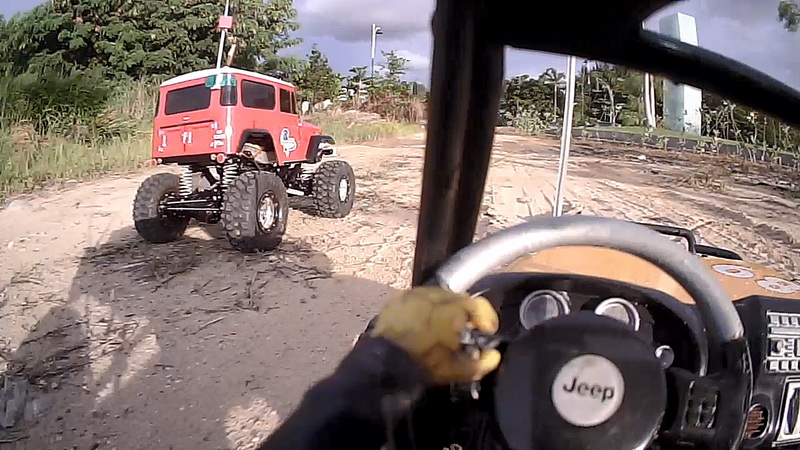 because you're 'immersively' moving together with your model like driving inside a real automobile in miniature world. Unlike FPV flight which can be flown in bigger unobstructed open space the FPV driving concentrate the thrill of driving through various obstacles, socially competing with other driver during tandem racing or co-op convoy driving, the experience to emulate 4x4 driving in smaller scale against harsh environment, taking pride your driving capability overcoming nature and technical difficulty. The aesthetic of driving inside the cockpit surrounded with artificial panels, steering wheels, dashboards and co-driver added extra reality for those enjoy more realistic driving experience.
because you're 'immersively' moving together with your model like driving inside a real automobile in miniature world. Unlike FPV flight which can be flown in bigger unobstructed open space the FPV driving concentrate the thrill of driving through various obstacles, socially competing with other driver during tandem racing or co-op convoy driving, the experience to emulate 4x4 driving in smaller scale against harsh environment, taking pride your driving capability overcoming nature and technical difficulty. The aesthetic of driving inside the cockpit surrounded with artificial panels, steering wheels, dashboards and co-driver added extra reality for those enjoy more realistic driving experience.
From my point of view being an avid fans of dirt racing and off-roading i love the thrills of speed with hit and misses, the intense cockpit experience bouncing around the terrains, drifting out into corners with sudden abrupt steering movement, the G-force sensation slalom around the trails, the force feedback acceleration and navigation skills. Seeing all those mechanical movement especially the front wheel and suspension system accompany by roaring engine sound give sense of triumph of engineering over mother nature to go in and out of the trails safely....in short words FPV driving is all about extreme adventures on wheels.
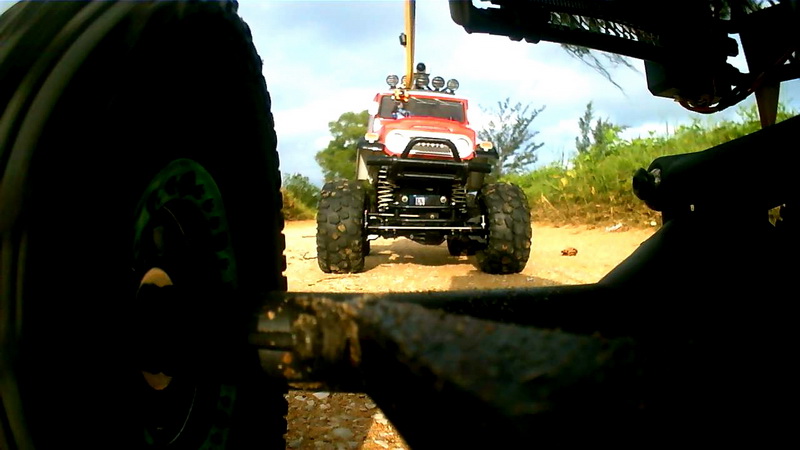
Safety and technical issue
Unlike FPV aircraft like fixed wing and multirotors FPV off-roader doesn't pose much risk to public interest nor brush with any existing drone/FPV law and regulation set by authority which happened to applied a lot on any air flight capable platform. However its general rules still applied through common sense where FPV driver prohibits from driving into busy public roads and any places which share the same space as FPV ground models. Much of the risk worried by all FPV driver is getting its model stuck between obstacles, lose video/radio range or get risk car/truck napped by the public.
Some technical issues during FPV are basically part of normal problem that any common R/C'er more likely encounter during long period of time when owning an FPV off-roader. Below are lists of problem might expect to arise.
-
Leaky oil shock damper due to over weight setup.
-
Squashed on both antenna due to roll over.
-
Lack of rear view on basic setup (rear viewable mirror). Worries who might show up behind the model by surprise....in coming pedestrians, dogs, motorist or accidental reverse into drainage/pit.
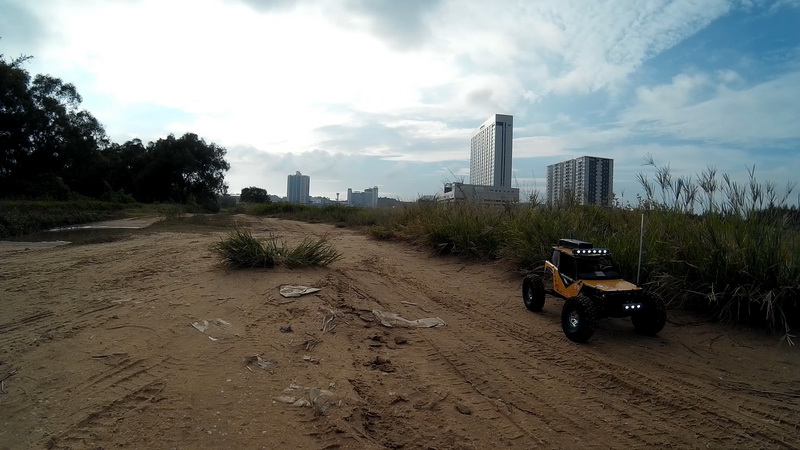
Pros and Cons
Here are list of Pros and Cons on running an FPV off-roader in comparison to other popular models such as fixed winged and multirotors:
Pros:
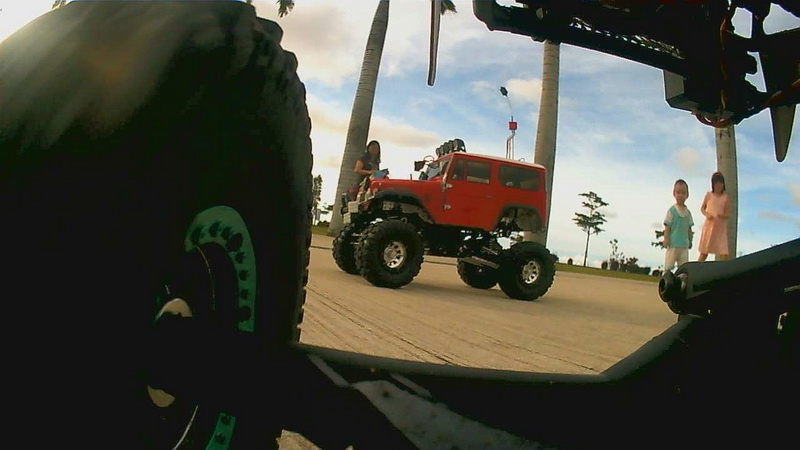 Its stays on the ground, so you can take your time and relax unlike being in the air.
Its stays on the ground, so you can take your time and relax unlike being in the air.- Lots of runtime and more curious places to discover around the block.
- Self adventure anywhere and anytime you want.
- Not bound to and rules, regulation or any drone law unlike flight drones in restricted flight areas. (FAA, NTSB or other government ruling agency).
- Scale and attractive model appearance of actual vehicle replica which make it looks appealing to public view.
- Fun both FPV driver and public spectator.
- Will attract more public attention and enthusiast around you. You might have to get in some conversation with curious and interest public about your models and give them some tips. Happens a lot during my FPV off-roading activities 100% of the times.
Cons:
 Get dirty and dusty easily, so more house keeping and maintenance work to keep the model clean and fit to operate.
Get dirty and dusty easily, so more house keeping and maintenance work to keep the model clean and fit to operate.- Parts worn out faster on the ground than in the air eg: tires, gears and drivetrains.
- If models breakdown, roll over or stuck somewhere on the ground its going to be a long distance walk to retrieve it.
- Radio frequency penetration on both controller and and video transmission is almost 1/3 efficiency (30%) compare to 100% efficiency on flight models due to ground obstacles radio penetration problem. So what you get flying in the air with 5.8Ghz 200mw VTX give you average 4~5KM of open air range but crawling on the ground due noise and obstacles you are likely to get only 300~500m from average to random value. Still with ground size of minimum '300m x 300m' its a handful size for a 1:10 scale FPV off-roader to roam around.
- Risk of car-napping (model kidnapped) if stray to far into unknown.
- Unable to predict what coming behind the model...incoming pedestrian or automobiles unless rear viewable mirror installed. A video transmitter with microphone build in can be a solution do listen to incoming object behind the model.
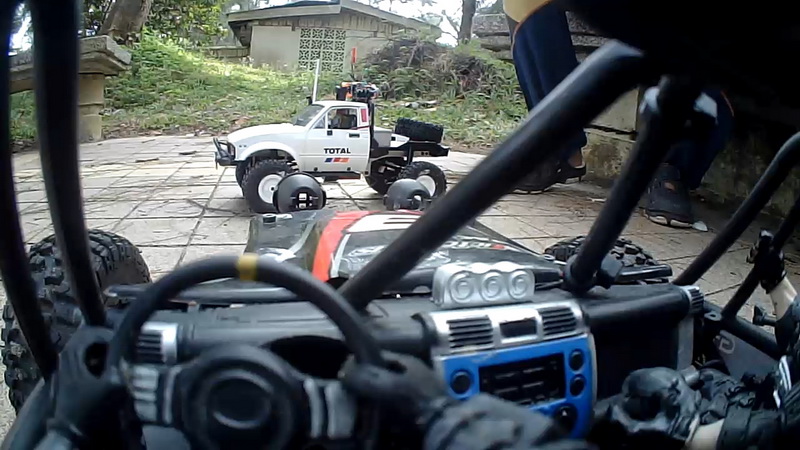
Social benefit
To highlight one of Pros about FPV driving as mentioned above list is about social benefit around public environment. Speaking through my past and current experience driving an FPV off-roader around public venue can be socially attractive to other people because more people started to realized 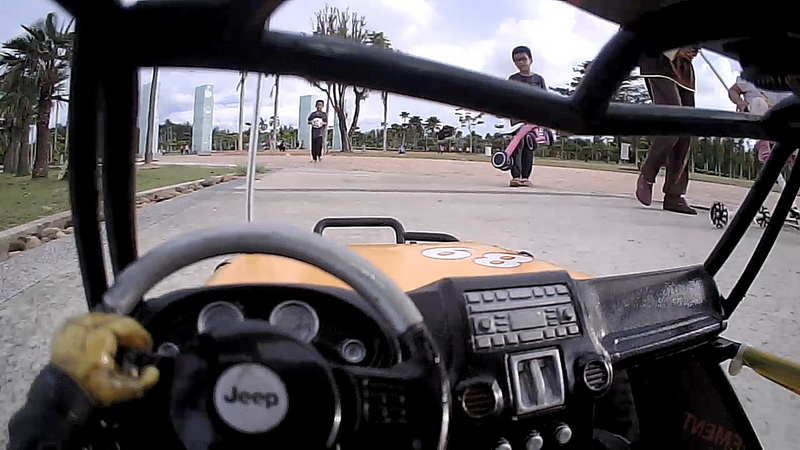 there's more than just flying FPV/Drones models in the air or just driving an Radio Control car/truck model. That little R/C car and truck running around the public park especially in convoy with no visual R/C driver standing around in the vicinity gave public spectator wondering, generate curiosity, and enthusiasm to world of R/C car/trucks models especially if your R/C model retain its attractive appearance of replica automobile such as Jeep, life like 4x4 models or realistic looking race car/truck instead of typical robotic ground drone appearance.
there's more than just flying FPV/Drones models in the air or just driving an Radio Control car/truck model. That little R/C car and truck running around the public park especially in convoy with no visual R/C driver standing around in the vicinity gave public spectator wondering, generate curiosity, and enthusiasm to world of R/C car/trucks models especially if your R/C model retain its attractive appearance of replica automobile such as Jeep, life like 4x4 models or realistic looking race car/truck instead of typical robotic ground drone appearance.
Crowds of curious and enthusiastic public from children from adult from various gender always gather around us FPV driver during and after our FPV off-roading session. They usually paused with confused look and smiled asking question about FPV off-road model, we would give them a tryout driving through our FPV video goggle, teach them how FPV things works, tips how to start FPV hobby, some useful resource reference and etc to make sure they 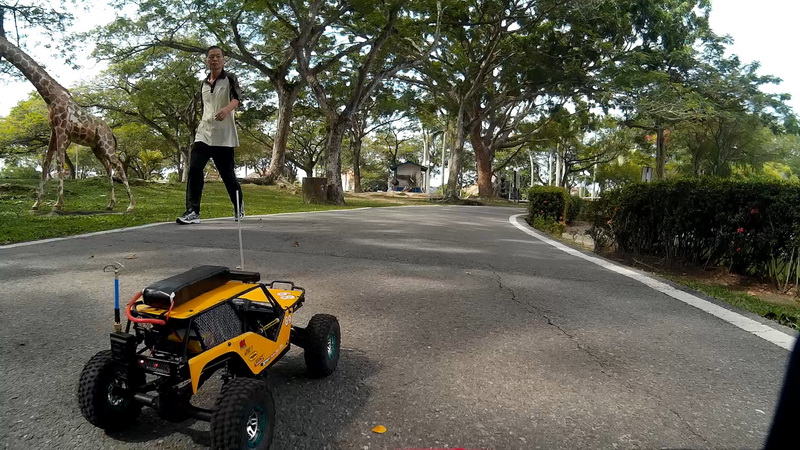 are well informed let them know how much enjoyment they could enjoy if they wanted to pursue this hobby by pointing them the right path. We had long chat, some laugh, we shook hands, ended up friends and we assimilate well with general public by our constant presence around the park every weekends. The youngster and family seems to be amused and entertained seeing our FPV models stroll along the path which makes the local park more lively especially if the models looks 'cute' and related to scale replica of existing automobile like TOYOTA, JEEP and etc...its a stark contrast when comparing with buzzing air borne models FPV/drones like DJI Phantom, Mavic, Walkeras, whizzing FPV racing quad or even fixed wing flying above their heads intruding air space and personal privacy invasion from above which has long gave bad reputation when flown in the wrong hands especially flown in restricted zone....yes those flying razor blade sometimes are not acceptable in some places. So if you want to meet some friendly people with FPV models then drive a 4x wheeler....there's a lot of Youtube of FPV'er driving their FPV off-roader/truck around public places stop by blow horn caught people by surprise, people just smiled back and being friendly amaze thing model came out of nowhere to entertain the public. Its like seeing little puppy or kittens roaming around places, stop by and greet at you....hehehe!
are well informed let them know how much enjoyment they could enjoy if they wanted to pursue this hobby by pointing them the right path. We had long chat, some laugh, we shook hands, ended up friends and we assimilate well with general public by our constant presence around the park every weekends. The youngster and family seems to be amused and entertained seeing our FPV models stroll along the path which makes the local park more lively especially if the models looks 'cute' and related to scale replica of existing automobile like TOYOTA, JEEP and etc...its a stark contrast when comparing with buzzing air borne models FPV/drones like DJI Phantom, Mavic, Walkeras, whizzing FPV racing quad or even fixed wing flying above their heads intruding air space and personal privacy invasion from above which has long gave bad reputation when flown in the wrong hands especially flown in restricted zone....yes those flying razor blade sometimes are not acceptable in some places. So if you want to meet some friendly people with FPV models then drive a 4x wheeler....there's a lot of Youtube of FPV'er driving their FPV off-roader/truck around public places stop by blow horn caught people by surprise, people just smiled back and being friendly amaze thing model came out of nowhere to entertain the public. Its like seeing little puppy or kittens roaming around places, stop by and greet at you....hehehe!
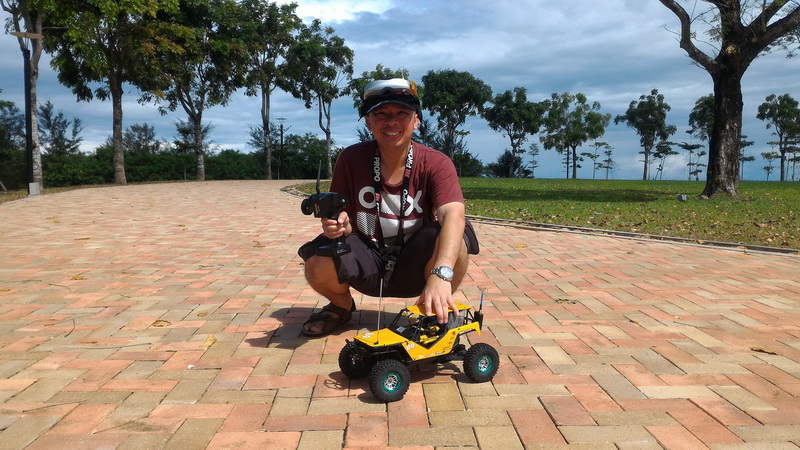
My current status & ground FPV model history (as on 11 Nov 2018)
Below are lists of my FPV off-roader that have been build and still active to this day when this article was written (21 Oct 2018). FYI there are actually more ground based FPV models have been made but only the below model made some highlights.
-
1:16 scale TOYOTA FJ
This is my first successful attempt building scale FPV driving via cockpit, the first prototype without splurging too much budget by acquiring cheap toy grade licensed Toyota 2WD model from toy shop and added most basic FPV hardware available which uses the same FPV hardware i used building an FPV Wl-toys V929 beetle multirotor half decades ago. With internal electronics replaced with full proportional servo, esc and 9X radio stick + basic FPV with OSD the model can drive over 80m limited by its poor 2WD traction, slippery toy grade tires and fragile gearbox. Despite being fragile it was proven that scale FPV driving via cockpit was feasible. *(FPV driving distance: 80m)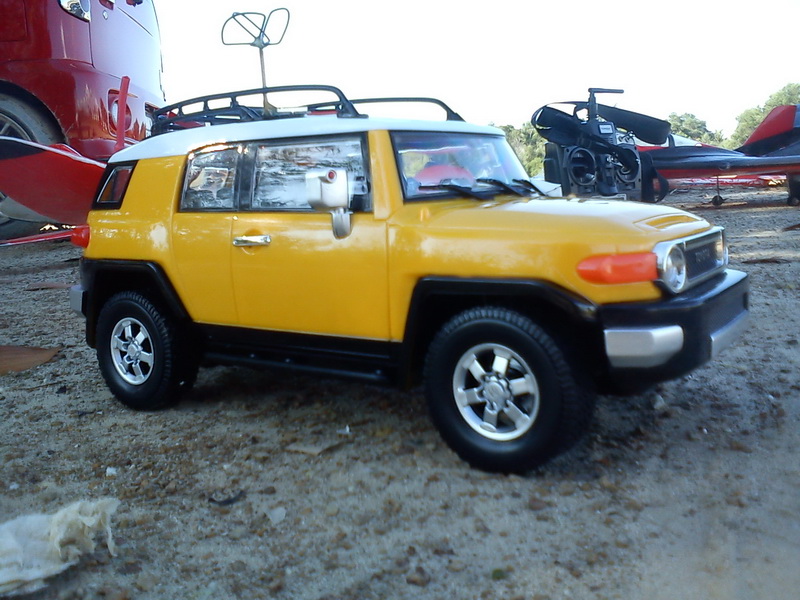
-
 1:16 CEN Racing Mini Madness
1:16 CEN Racing Mini Madness
This is my second attempt building an FPV off-roader back in the old days/ Although there's not much FPV videos available about this model i made it does teach me few things technical things and challenges in moving forward building a proper ground FPV vehicle. Its a 2WD monster truck chassis and build to have bulk size pan and tilt capable FPV viewing angle. Successfully driven pass 450m distance but was plaque with many unforeseen technical difficulty such as loss video range, loss control range, BEC failure, ESC over heating, power surge during throttle and getting stuck through obstacles due to improper 2WD characteristic. This model taught me a lot of challenges and how to overcome technical difficulties building a proper FPV off-roader which lead ways to future improvement on later build. *(FPV driving distance: 200m)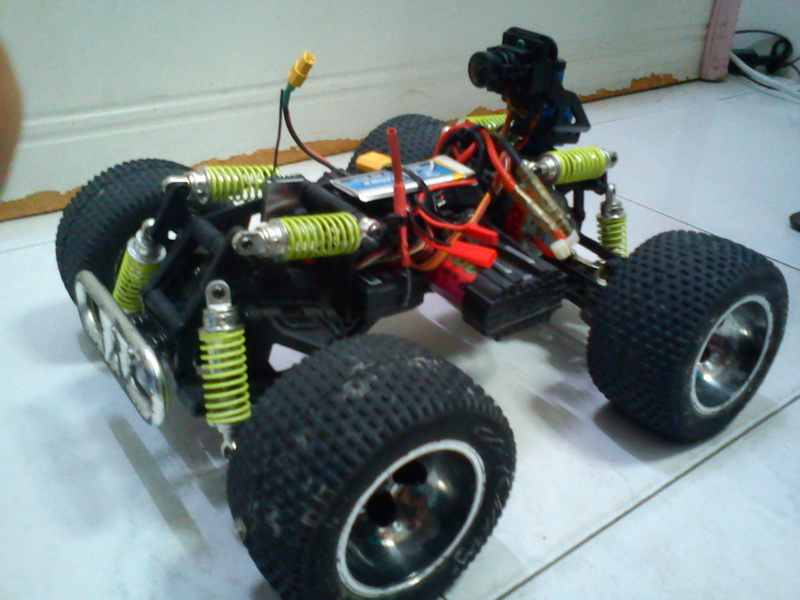
-
1:24 Hobby King BASHER ROCSTA
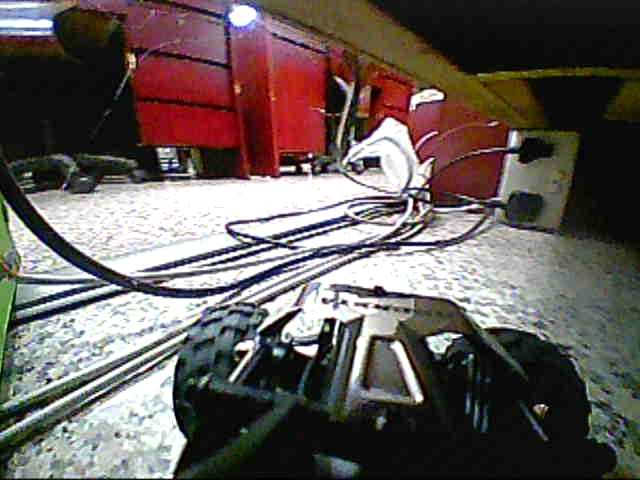
One of my favorite FPV build ideal to run around indoor or outside the house close by within 80m range. Its unique quirk was the ability to crawl around tight narrow places down under rubbles, wall cracks, holes, messy places and under the furniture great for remote inspection like checking pipes, floor wiring or hidden spot backyard where only rodent size animal can access. Running on stock out of box RTR radio and electronics only added simple FPV camera, pan servo and video transmitter just to get it running. *(FPV driving distance: 50~80m)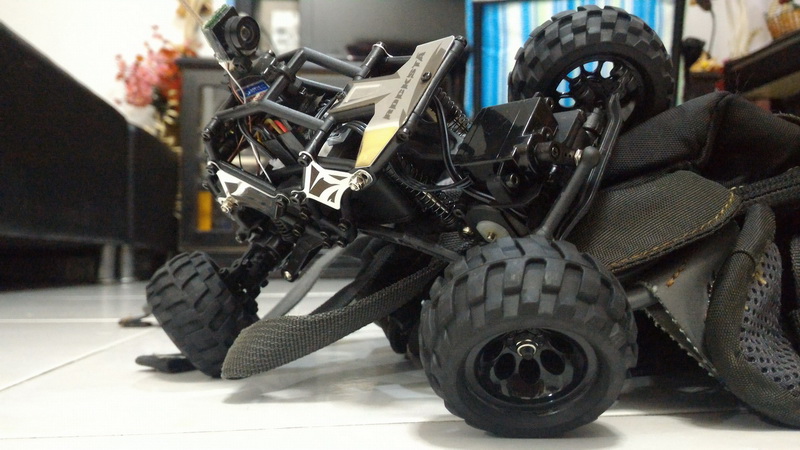
-
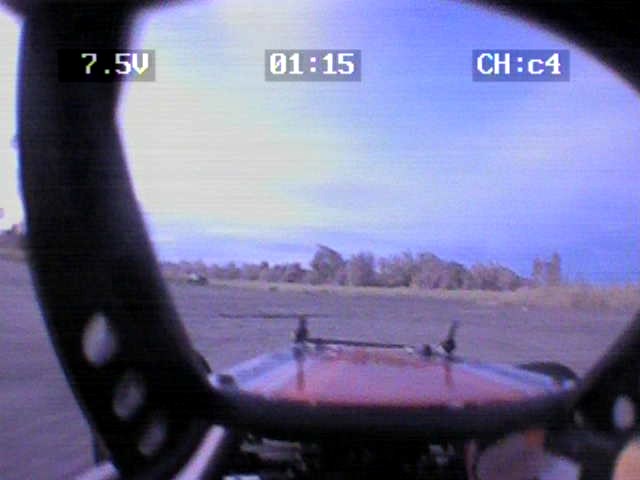 1:14 EACHINE F-14 Ratingking FPV Buggy
1:14 EACHINE F-14 Ratingking FPV Buggy
Sent over by Banggood.com for test and review its actually the first hobby grade FPV buggy made available to consumer and first attempt by EACHINE to venture into ground FPV arena. The FPV hardware that comes with this package was top notch and high quality but unfortunately the implementation method was a flaw because the buggy was too struggle to drive around as FPV due to short ground clearance and in my opinion they should opt for taller buggy with lots of ground clearance to make it possible to roam around on rough terrains. Current status; the FPV equipment was detached from the buggy and placed on proper bigger size off-road models while the F-14 buggy used and normal line of sight driving like any standard R/C use. *(Driving distance: 189~200m)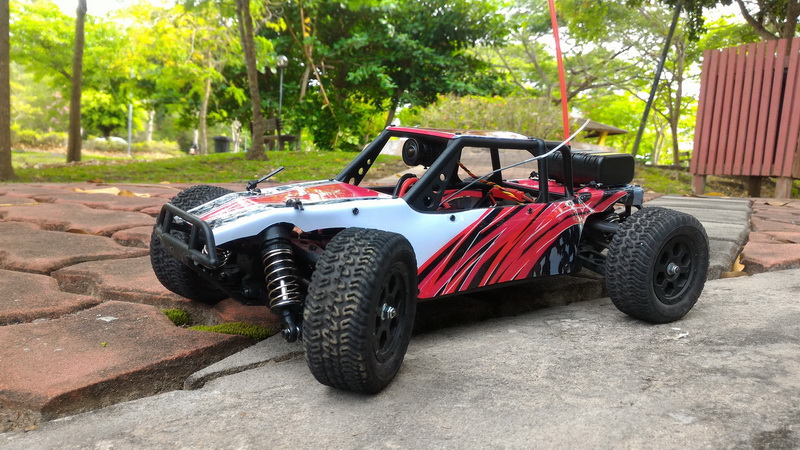
-
1:12 FY03 FeiYue (mini replica clone of Vaterra Twin Hammer)
This is my successful pioneering scale cockpit FPV driving build that become benchmark and guide for all my next generation FPV off-roader build. This platform is actually miniaturized 95% exact replica version of VATERRA TWIN HAMMER at 1:12 scale without 2 speed manual switchable gearbox and today it has become standard 1:12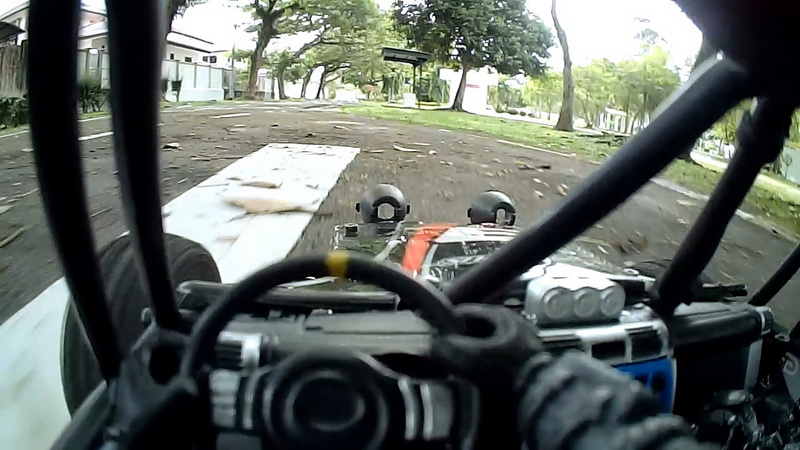 Trophy truck platform for many R/C brands to follow. Although 1:12 scale known to be smaller than 1:10 but actually by wheelbase size and ground clearance it actually has almost the same size and off-road performance size equal to 1:10 rally car or SUV which mean it can easily fit 1:10 scale shell bodyshell from touring car, rally or SUV kit. The fitting for FPV hardware is very tight and compact which required careful wiring and weight reduction . The Pros of having this scale size is i can easily obtain cockpit dash panel, steering wheel and figurine driver from toy shop which is abundant within 1:14~1:16 scale that fit nicely into the interior of 1:12 FY03. Among all my FPV off-road collection in current time (at the time of writing this article) the FY03 remains the fastest 4WD off-roader on any moderate terrains without getting stuck in difficult situation and also have more aesthetic scale appearance inside the interior cockpit than any FPV off-roader i have in my build collection and also on the internet and FPV'er community. If you pay attention to all my FY03 video you might realized that dashboard looks soooo familiar.....hehehe! *(FPV driving distance: 800~1000m)
Trophy truck platform for many R/C brands to follow. Although 1:12 scale known to be smaller than 1:10 but actually by wheelbase size and ground clearance it actually has almost the same size and off-road performance size equal to 1:10 rally car or SUV which mean it can easily fit 1:10 scale shell bodyshell from touring car, rally or SUV kit. The fitting for FPV hardware is very tight and compact which required careful wiring and weight reduction . The Pros of having this scale size is i can easily obtain cockpit dash panel, steering wheel and figurine driver from toy shop which is abundant within 1:14~1:16 scale that fit nicely into the interior of 1:12 FY03. Among all my FPV off-road collection in current time (at the time of writing this article) the FY03 remains the fastest 4WD off-roader on any moderate terrains without getting stuck in difficult situation and also have more aesthetic scale appearance inside the interior cockpit than any FPV off-roader i have in my build collection and also on the internet and FPV'er community. If you pay attention to all my FY03 video you might realized that dashboard looks soooo familiar.....hehehe! *(FPV driving distance: 800~1000m)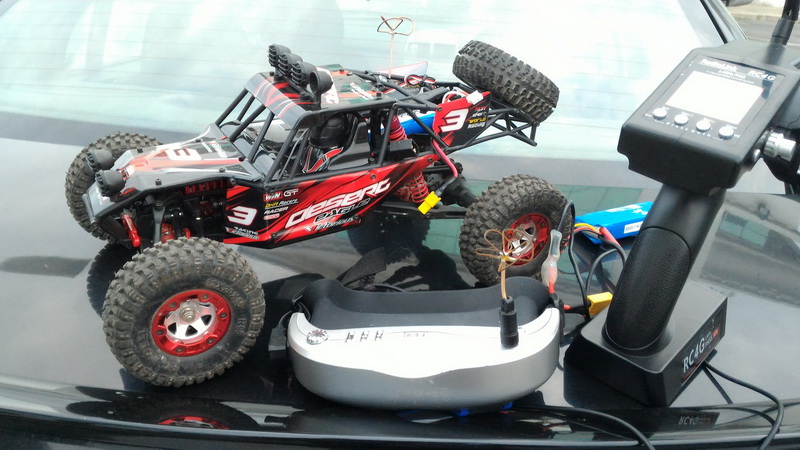
-
1:10 WL-Toys K949/Hobby King A333 (Vaterra Twin Hammer clone)
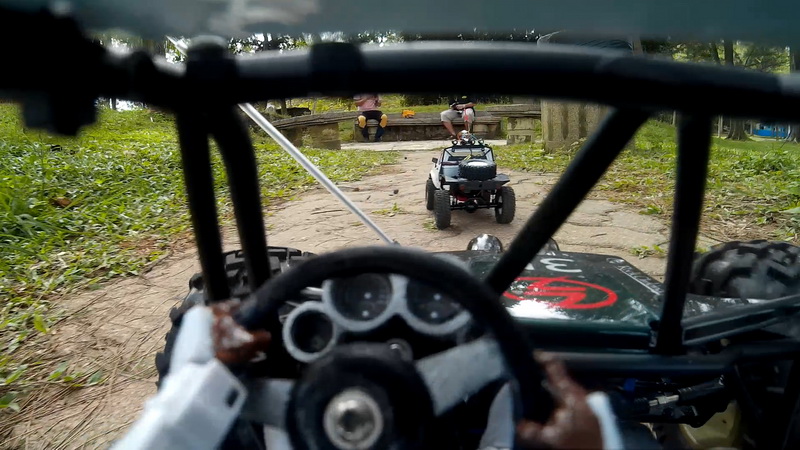
This is the grand daddy that started the rave using 100% Vaterra Twin Hammer platform..the original clone before its started to spread out to become many variant by many manufacturer from WL-Toys, Hobby King (A333), JJRC and etc. Its the only 1:10 scale trophy truck which i see could perform both high speed all-terrain driving and high torque climbing power without burning holes in the pocket and still looks good in appearance from the outside. Today this platform grows well in the market with abundant of parts support and hops-up accessories. My K949 gone through many physical changes, as for late year 2018 the model now having a bright red Ferrari color scheme and matte gold coated rims. *(FPV driving distance: 800~1200m)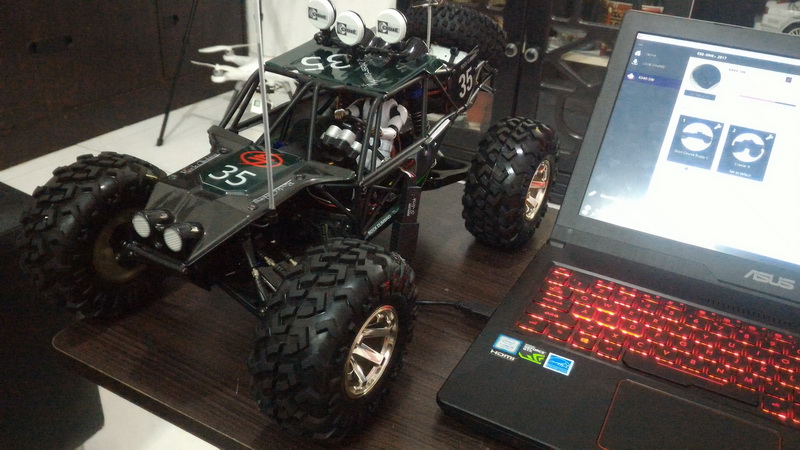
-
1:10 HuanQi 739 buggy (TEAM-C TC-02 clone)
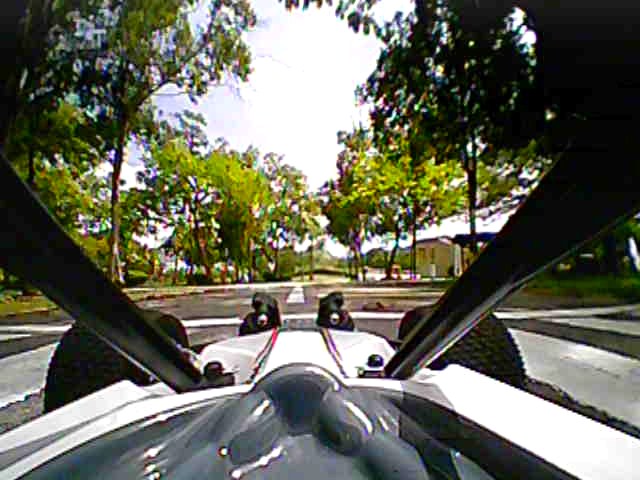 My favorite all weather high speed basher build with intend for thrill of speed, maintenance/cleaning simplicity and enjoy some power slide around the corner both on tarmac and dirt track provided no obstacles that cause 'wheel trap' like roots and ditches because its purely rear 2WD drivetrains. The FPV setup are intermediate level but not as complicated and advance as what seen on Feiyue FY03, K949 and 10428A FPV schematics but enough to enjoy FPV racing throughout the driving course. Driven from cockpit view it has semi scale 'aesthetic' setup which mean the cockpit doesn't have steering movement or solid dash panel nor even sound engine emulation sound system for realistic engine 'roaring' under the hood. All this to keep the setup simplified, less weight and less power consuming which mean more runtime thus concentrate more on thrill of speeding and bashing without worry to much broken parts and stress on onboard hardware. Its also ideally driven on wet condition and rainy days because most of the electronics is fully enclosed under the plastic lexan body shell and not much dirt or grime going into simple 2WD gear transmission. Driving FPV on a 2WD is very different than on 4WD/AWD because the grip are more 'loose', chaotic and drift a lot or should i say power sliding due to mass rear throttle torque on back wheel which give the feeling of 'G-Force' sensation and train driver to be a skilled racer. *(FPV driving distance: 800~1000m)
My favorite all weather high speed basher build with intend for thrill of speed, maintenance/cleaning simplicity and enjoy some power slide around the corner both on tarmac and dirt track provided no obstacles that cause 'wheel trap' like roots and ditches because its purely rear 2WD drivetrains. The FPV setup are intermediate level but not as complicated and advance as what seen on Feiyue FY03, K949 and 10428A FPV schematics but enough to enjoy FPV racing throughout the driving course. Driven from cockpit view it has semi scale 'aesthetic' setup which mean the cockpit doesn't have steering movement or solid dash panel nor even sound engine emulation sound system for realistic engine 'roaring' under the hood. All this to keep the setup simplified, less weight and less power consuming which mean more runtime thus concentrate more on thrill of speeding and bashing without worry to much broken parts and stress on onboard hardware. Its also ideally driven on wet condition and rainy days because most of the electronics is fully enclosed under the plastic lexan body shell and not much dirt or grime going into simple 2WD gear transmission. Driving FPV on a 2WD is very different than on 4WD/AWD because the grip are more 'loose', chaotic and drift a lot or should i say power sliding due to mass rear throttle torque on back wheel which give the feeling of 'G-Force' sensation and train driver to be a skilled racer. *(FPV driving distance: 800~1000m)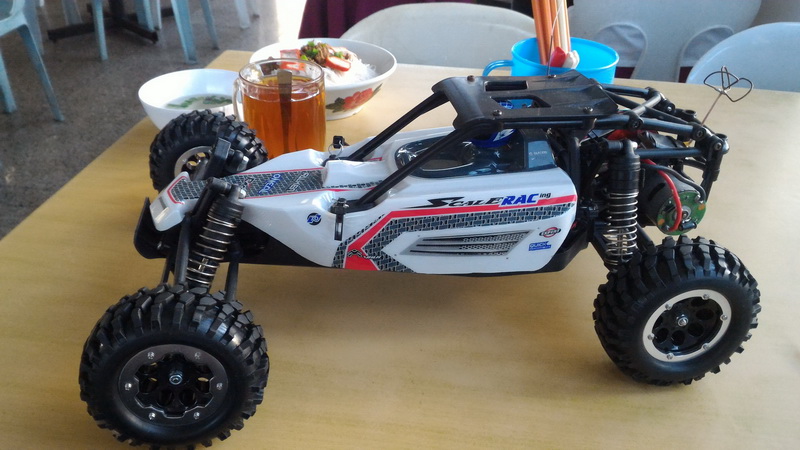
-
1:10 WL-Toys 10428A aka K949 (Vaterra Twin Hammer clone)
 This is most used scale FPV truck i used a lot on all my FPV driving videos especially when driving with my buddy through convoy style adventures. The truck have style, nice interior scale cockpit with Jeep Rubicon style dashboard, great view layout, have horns, great engine sounds, powerful front DIY fog and roof LED lights make driving experience more realistic and aesthetically cool! Like most of the FPV truck i own this one need lots of cosmetic work and DIY modification to make it the way how it looks today and most R/C enthusiast mistaken identify this as AXIAL WRAITH despite it looks similar but by size its different. By comparison AXIAL Wraith used 2.2 wheel/tire size while 10428A including its twins the K949 used 1.9 wheel/tire size. The 10428A share 100% same platform as the K949 both the chassis layout, mechanism and also the FPV setup but with minor setback; the gear switching servo has been removed to make extra channel for HORN sound function and FPV recorded at 720P HD because the camera module is small enough to fit inside the scale drive helmet. The 10428A has skeletal jeep style top body while the K949 remains as standard trophy truck style body. *(FPV driving distance: 800~1200m)
This is most used scale FPV truck i used a lot on all my FPV driving videos especially when driving with my buddy through convoy style adventures. The truck have style, nice interior scale cockpit with Jeep Rubicon style dashboard, great view layout, have horns, great engine sounds, powerful front DIY fog and roof LED lights make driving experience more realistic and aesthetically cool! Like most of the FPV truck i own this one need lots of cosmetic work and DIY modification to make it the way how it looks today and most R/C enthusiast mistaken identify this as AXIAL WRAITH despite it looks similar but by size its different. By comparison AXIAL Wraith used 2.2 wheel/tire size while 10428A including its twins the K949 used 1.9 wheel/tire size. The 10428A share 100% same platform as the K949 both the chassis layout, mechanism and also the FPV setup but with minor setback; the gear switching servo has been removed to make extra channel for HORN sound function and FPV recorded at 720P HD because the camera module is small enough to fit inside the scale drive helmet. The 10428A has skeletal jeep style top body while the K949 remains as standard trophy truck style body. *(FPV driving distance: 800~1200m)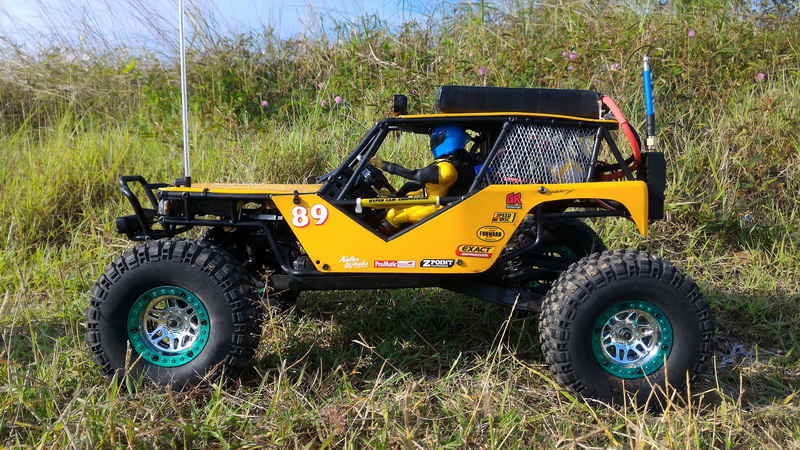
Summary
First of all i would like to thanks the RCGROUPS forum of the people who drove FPV SUMMIT Tonka community for giving so much inspiration for their involvement in making FPV driving a dream come true. Their past videos 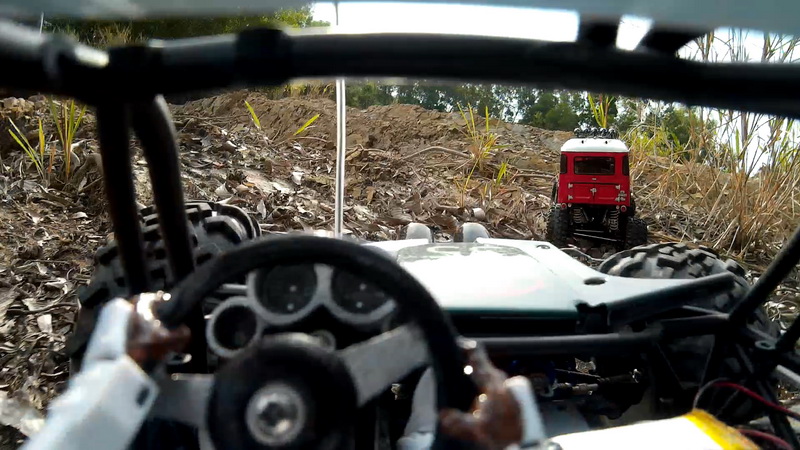 what's keeps my FPV off-road building and driving enthusiasm alive. Without a doubt the FPV off-roading or any ground FPV activity started to grow rapidly this year as more and more people realized the fun and thrilling factor driving from cockpit point of view, roof or on the hood.
what's keeps my FPV off-road building and driving enthusiasm alive. Without a doubt the FPV off-roading or any ground FPV activity started to grow rapidly this year as more and more people realized the fun and thrilling factor driving from cockpit point of view, roof or on the hood.
Today i had an army of cool scaled looking FPV off-roader....i'm proud, lol! so much for my eccentric ego but everyone should be proud of their work...that's positive pride especially when achieved ambition driving R/C car inside the cockpit which was long sought after since my childhood days. After almost a decade FPV driving my off-roader from inside the cockpit i've never got bored, constantly customizing and upgrade my FPV truck for aesthetic looks and enhance the driving experience. FPV driving always give so much adrenaline thrills equal to FPV quad racing and also scale cockpit style FPV fixed wing flying with different prospect. It also attract more public interest since its base root derived from R/C car and truck where its more appealing to wide audience regardless age, skills and personal background. This year FPV driving seems to caught more attention in the community and even my buddy started to do more frequent FPV driving than flying, they enjoy tag along with me for a cool tandem convoy style driving on weekends. Its cool to see we're driving together 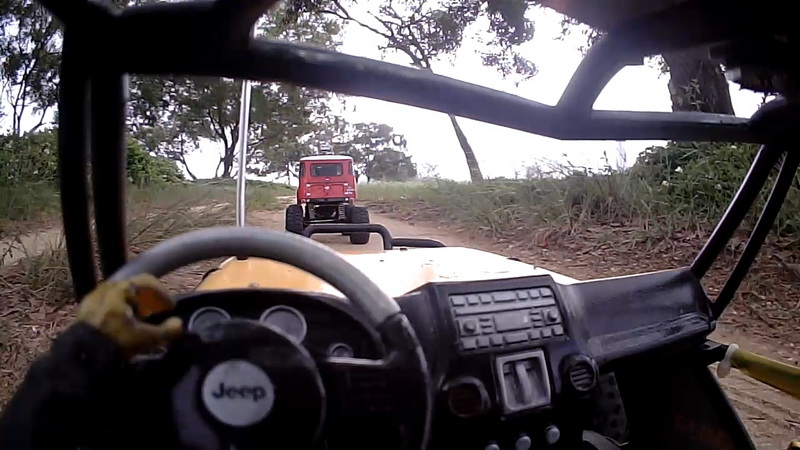 side by side doing long distance driving as if we're doing a real 4x4 jamboree into unknown plus its proud to have elegant piece of scale off-roading machinery driving side by side with our chrome wheels, cool body kits, showing our prowess driving skills and admires suspension system soaking all the terrains and obstacles as big tires rolls over the soil. Radio Control driving have reach its new pinnacle of technology where we no longer have to stare from third person view or standing view point, we are now can enjoy driving from cockpit like in video game or real driving view in miniature driving world without any legal risk yet contribute growth of new exciting world of FPV on wheels.
side by side doing long distance driving as if we're doing a real 4x4 jamboree into unknown plus its proud to have elegant piece of scale off-roading machinery driving side by side with our chrome wheels, cool body kits, showing our prowess driving skills and admires suspension system soaking all the terrains and obstacles as big tires rolls over the soil. Radio Control driving have reach its new pinnacle of technology where we no longer have to stare from third person view or standing view point, we are now can enjoy driving from cockpit like in video game or real driving view in miniature driving world without any legal risk yet contribute growth of new exciting world of FPV on wheels.
The future for FPV driving are more promising as the technology catching up to improve overall FPV experience and FPV community started to take notice on ground pounder. More and more ground based model are produced in the market around the world like touring cars, pan racer, buggies, truggy, trucks, monster trucks, crawlers and other wheeled models when compare against multirotor/quads and fixed wing as long boys will be boys and adults will bef around to get some kicks with R/C hobby. As for me more likely my FPV off-roader will be fitted with beautiful yet $$$ aluminums upgrades, chrome wheels, Nitrous tanks and MOMO steering wheels....get some blings for my ride, lol.

Videos/Medias
![]() Here are some of my video and gallery related to the above topics:
Here are some of my video and gallery related to the above topics:
- Gallery for 1:10 scale: 1/10 AXIAL custom build 2.2 comp
- Gallery for 1:10 scale: 10428A Wild Truck Warrior
- Gallery for 1:10 scale: 1/10 Wl-toys K949 aka Vaterra Twin Hammer
- Gallery for 1:10 scale: 1/10 HuanQi 739 Desert Buggy
- Gallery for 1:12 scale: Feiyue FY03 Eagle-3 1/12 2.4G 4WD Desert Off-Road Truck
- Gallery for 1:10 scale: 1/10 Tamiya WILD WILLY 2
- Gallery for 1:14 scale: 1/14 EACHINE RatingKing FPV Buggy
- Gallery for 1:24 scale: 1/24 Basher Rocksta FPV micro crawler
- My Youtube channel: 3DXL
- My Videos:
- FPV truck WLToys 10428A - Rainy Night
- FPV truck AXIAL Maxximus XL2 - Swamp land extreme!
- FPV truck AXIAL Maxximus XL2 - Wet drizzle night convoy
- FPV truck AXIAL Maxximus XL2 - Mudding Time with RocHobby Jeep
- FPV truck WL-Toys K949 vs 10428 - Need for speed racing ..watch the ending
- FPV truck AXIAL Maxximus XL2 - Beach Day!
- FPV truck WLToys 10428A - Urban Exploration 2.0 gone wrong
- FPV truck Wild Willy 2 - Urban Exploration 1.0
- FPV truck AXIAL Maxximus - The hanging bridge
- FPV truck AXIAL Maxximus XL2 - Stucked Up Rescue 911
- FPV truck WL-Toys K949 - Around the Park
- FPV truck TAMIYA WILD WILLY 2 - Fun Grand Prix
- FPV truck WL-Toys K949 and 10428 - Public Night Drive
- FPV truck AXIAL Maxximus vs Jeep Willy - Extreme Crawler Attack
- Quick Race - FPV truck WLToys 10428A
- FPV rock crawler - The AXIAL MAXXIMUS 2.2
- How to build FPV on Tamiya WILD WILLY 2 for cockpit style drone driving
- FPV Tamiya Wild Willy 2 - Park Drive
- FPV Night Super Trails - 4x4 drone off-roading: K949 Twin Hammer vs Tamiya Land Cruiser
- FPV Pitch black night - 4x4 drone off-roading: 10428A Twin Hammer vs Tamiya Land Cruiser
- FPV 4x4 Re-Public - drone off-roading: 10428A@Twin Hammer vs Tamiya Land Cruiser
- FPV Dirt Rally - drone off-roading: 10428A@Twin Hammer vs Tamiya Land
- FPV truck TAMIYA WILD WILLY 2 - Speed Run
- FPV truck TAMIYA WILD WILLY 2 - Shorcuts
- Ultimate! FPV 4x4 CONVOY - 10428A @Twin Hammer + Tamiya Land Cruiser
- FPV Wolf pack - 10428A @Twin Hammer vs Tamiya Land Cruiser
- FPV K949 Twin Hammer: Escort Mission of WPL C14
- G-Force: FPV K949 + ESS-ONE Turbo charged V8
- FPV Feiyue FY03 - ESS-ONE Twin Turbo V8 sound - Track day
- FPV K949 with ESS-ONE Turbo charged V8 sound - Test Drive
- FPV 10428A ESS-ONE V8 Turbo - Maze Runner
- FPV 10428A truck with ESS ONE engine sound V8 Turbo
- Formula-1XXL - HuanQi 739 1:10 2WD Desert Buggy
- FPV cockpit drive! - HuanQi 739 1:10 2WD Desert Buggy
- FPV Basher Rocksta micro crawler - Office adventure 2
- FPV Basher Rocksta micro crawler - Modern jungle
- FPV Basher Rocksta micro crawler - The builds and Man Cave adventures
- FPV Off-roading - Feiyue FY03 Eagle-3 Desert Truck
- FPV Extreme Rock Crawling - Feiyue FY03 Eagle-3 Desert Truck
- FPV Cross Road 2 - Feiyue FY03 Eagle-3 Desert Truck
- FPV Scale Run - Feiyue FY03 Eagle-3 Desert Truck
- FPV on android smartphone with DVR using EasyCap
- FPV Fun beach drive - Feiyue FY03 Eagle-3 Desert Truck
- FPV Test Drive – Toyota FJ Cruiser 1:16 scale
Shopping list
Here i've listed some raw material, hardware and stuff where you can start building your own FPV off-roader model. The list contain same hardware parts i used on my FPV off-roader above and also include some compatible/alternative ones which you can pickup what suits best for your need and your budget. So come dig around and start your scale FPV driving ambition:
** Take note the one with marked (*) is the default hardware i use on my setup while the non mark ones are compatibles.
- Platform (Based the off-road model i've been using):
- *WLtoys 10428 1/10 2.4G 4WD RC Monster Crawler RC Car
- *Feiyue FY03 Eagle-3 1/12 2.4G 4WD Desert Off Road Truck RC
- WLtoys 12428 2.4G 1/12 4WD Crawler RC Car With LED Light
- *Feiyue FY-03 Eagle RC Car Kit For DIY Upgrade Without Electronic Parts
- Remo Hobby 1073-SJ 1/10 2.4G 4WD Brushed Rc Car Off-road Rock Crawler Trail Rigs Truck RTR
- *Wltoys 10428A 1/10 2.4G 4WD 30KM/h Racing RC Car 540 Brushed Motor Rock Climbing Truck
- Radio set/combo:
- *RadioLink RC4GS 2.4G 4CH Car Controller Transmitter + R4FG-G
- *Spare receiver with Gyro built-in: Radiolink R4EH-G Gyro Inside Receiver For RC4G Transmitter
- *Spare receiver with high voltage supported (4.6~10v max): Radiolink 2.4G 4CH HV R4EH-H Receiver
- Spare receiver without built-in Gyro: Radiolink FHSS R4F 2.4G 4 Channel Radio Control System RC4GS RX
- *100% compatible receiver from Hobbyking.com with Gyro built-in: TrackStar TS4G V2 2.4Ghz 4-Channel Gyro Integrated Receiver
- Latest 6 channel radio combo unit: RadioLink RC6GS 2.4G 6CH Car Controller Transmitter+R6FG Gyro Inside
- ESC:
- BEC:
- Servo:
- Servo for pan camera and cockpit steering:
- FPV Camera:
- HD recordable FPV camera and acessories:
- OSD module: Video transmitter:
- Video receiver/FPV LCD/FPV video goggle:
- Eachine EV100 720*540 5.8G 72CH FPV Goggles With Dual Antennas Fan 7.4V 1000mAh Battery For RC Drone
- Eachine EV200D 1280*720 5.8G 72CH True Diversity FPV Goggles HD Port in 2D/3D Built-in DVR
- Battery:
- *ZOP Power 7.4V 2200mAh 2S 45C Lipo Battery
- ZOP Power 7.4V 5000mAh 60C 2S Lipo Battery
- Gens Ace 7.4V 6800mah 50C 2S Lipo Battery T Plug for 1/8 1/10 RC Car
- Gaoneng 7.6V 8000mAh 100C 2S HV 4.35V Lipo Battery 5.0mm Banana Plug T Plug for 1:10 RC
- Gaoneng GNB 7.4V 4600MAH 2S 110C Lipo battery T Plug For RC Car
- *Gaoneng GNB 7.4V 5200mAh 100C 2S 1:12 38.48WH Lipo Battery T Plug For RC Car
- *Gaoneng GNB 7.4V 5000MAH 2S 120C Lipo Battery T Plug For RC Car
- Sound System
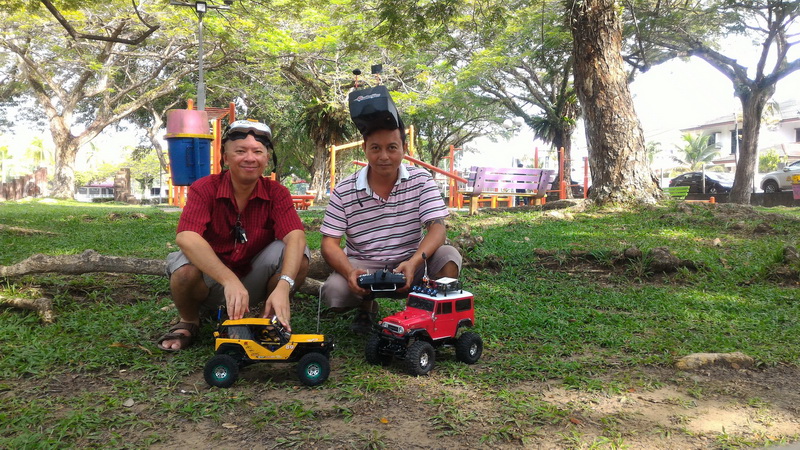
Building threads/Referral
If you don't know where to begin with i recommend you to start reading some guides, wikis and building tips from popular on-line resources as listed below. You might find me wondering around some popular R/C and FPV forum below.
- Rcgroups.com forum: FPV Car and Other Fun FPV Projects Thread *(very active community-daily updates)
- Rcgroups.com forum: FPV Tonka Summit
- Fpvlab.com forum: Ground Pounder
- Rctech.net forum: FPV rock crawling, development and building section
- Rcuniverse forum: FPV Vehicles
Related topic or hardware build dependency
Below are related article that are also part of hardware and custom add-ons used on my ground FPV models.
- Building ground FPV: Basher Rocksta micro crawler
- Product review: RADIOLINK RC4G radio transmitter (Radio range performance for FPV)
- Product review: Sense Innovations ESS-ONE (2017) simulated engine sound unit (Scale FPV add-ons)
- Use Smartphone as FPV with DVR display
- XL-RCP 44.0 Cockpit kit: For Radio Control models (3d printed parts for FPV)
